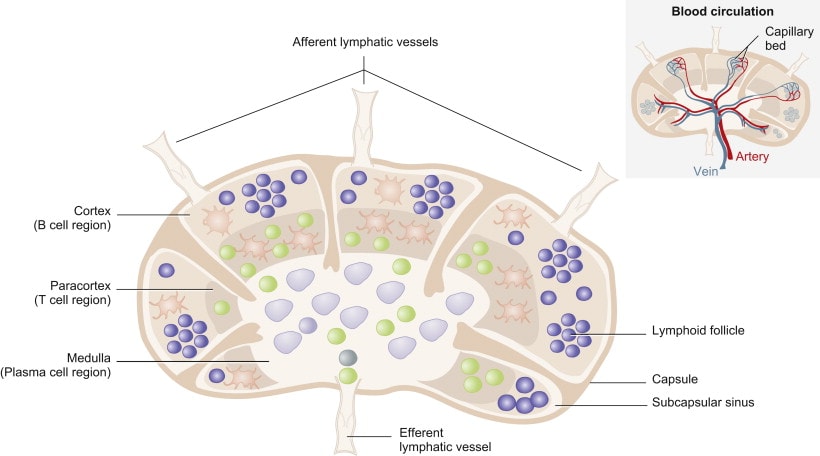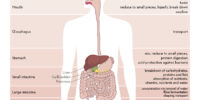Lymph Flow And Immune Response Explained

The immune system is a complex network of cells and tissues that work together to protect the body from harmful pathogens. One important component of the immune system is the lymphatic system, which plays a crucial role in maintaining immune function by transporting lymphatic fluid and immune cells throughout the body.
Understanding the anatomy and function of the lymphatic system is essential for understanding how the immune response works.
In this article, we will explore the anatomy of the lymphatic system, including its vessels and nodes, and the role of lymphocytes in fighting infection. We will also examine the process of inflammation and factors that affect lymph flow, as well as ways to support a healthy immune system.
Finally, we will discuss potential health issues related to the lymphatic system and how they can be managed. By the end of this article, readers will have a comprehensive understanding of lymph flow and immune response, and how these processes are essential to maintaining overall health and wellbeing.
Key Takeaways
- The lymphatic system is a component of the immune system that transports lymphatic fluid and immune cells throughout the body.
- Factors such as exercise and massage can enhance lymph flow, which can help improve immune system function.
- Inflammation is a biological process that occurs in response to tissue damage or infection and involves the recruitment of immune cells to the site of injury or infection.
- Lifestyle factors such as adequate sleep, stress management, regular exercise, and a well-balanced diet can support a healthy immune system.
Anatomy of the Lymphatic System
The lymphatic system, a network of vessels, organs, and tissues, plays a vital role in maintaining fluid balance and transporting immune cells throughout the body. It is a parallel circulatory system that works in tandem with the blood vessels to maintain the overall health of the body.
The lymphatic system consists of lymphatic vessels, lymph nodes, the spleen, the thymus, and the tonsils. Lymphatic vessels are thin-walled vessels that transport lymph, a clear fluid that contains immune cells, proteins, and other substances, from the tissues to the lymph nodes.
Lymph nodes are small, bean-shaped structures that filter lymph and trap foreign substances, such as bacteria and viruses. The spleen, located in the upper left part of the abdomen, filters blood and removes old or damaged red blood cells. The thymus is a small gland located in the chest that plays a crucial role in the development of T cells, a type of white blood cell that helps fight infection.
The tonsils are small masses of lymphoid tissue located at the back of the throat that help protect against infection. Overall, the lymphatic system works to maintain immune function and fluid balance, protecting the body against disease and maintaining overall health.
Lymphatic Vessels and Nodes
Lymphatic vessels and nodes play a crucial role in the transportation and filtration of interstitial fluid and immune cells.
The lymphatic vessels are thin-walled tubes that run parallel to the blood vessels, and they are responsible for collecting the interstitial fluid, which is the fluid that surrounds the cells in the body. The interstitial fluid contains waste products, proteins, and other substances that have leaked out of the blood vessels.
The lymphatic vessels transport this fluid to the lymph nodes, where it is filtered and purified before being returned to the bloodstream. The lymph nodes are small, bean-shaped structures that are found throughout the body.
They act as filters for the lymphatic fluid, removing bacteria, viruses, and other foreign particles that may have entered the body. The lymph nodes are also responsible for producing lymphocytes, which are a type of white blood cell that plays a crucial role in the immune response.
When the lymphatic fluid passes through the lymph nodes, the lymphocytes come into contact with the foreign particles, and they begin to multiply and produce antibodies that can neutralize the invading pathogens. Once the lymphatic fluid has been filtered and purified by the lymph nodes, it is returned to the bloodstream, where it can continue to circulate and provide nourishment to the cells in the body.
The Role of Lymphocytes in Fighting Infection
Lymphocytes, a type of white blood cell, play a crucial role in defending the body against infection by identifying and neutralizing invading pathogens. There are two main types of lymphocytes: B cells and T cells.
B cells produce antibodies that recognize and bind to specific antigens on the surface of invading pathogens, marking them for destruction by other immune cells.
T cells directly kill infected cells and coordinate the immune response by releasing cytokines, which signal other immune cells to target the infection. Lymphocytes undergo a complex process of development and activation in lymphoid organs, such as the thymus and bone marrow, before they can effectively combat infection.
Once activated, lymphocytes circulate through the lymphatic system and blood, surveying for signs of infection. When they encounter an antigen that matches their receptor, they rapidly multiply and differentiate into effector cells that specifically target the invading pathogen.
Through their diverse mechanisms, lymphocytes provide a powerful defense against infectious agents and play a vital role in maintaining overall health.
Understanding the Immune Response
Upon encountering an invading pathogen, the body’s complex web of immune cells and molecules work together to mount a targeted defense and eliminate the threat. The immune response is a highly coordinated and regulated process that involves a variety of cells, including white blood cells such as macrophages, neutrophils, and natural killer cells. These cells work together to recognize and destroy pathogens through a series of complex signaling pathways that involve the activation of specific genes and the release of cytokines, chemokines, and other signaling molecules.
One way to understand the immune response is to consider it as a series of steps, including recognition, activation, effector function, and resolution. During the recognition phase, immune cells identify the presence of a foreign pathogen and initiate a response. The activation phase involves the recruitment and activation of additional immune cells, which work together to eliminate the pathogen. The effector phase involves the release of cytokines and other signaling molecules that help to control the spread of the pathogen and limit damage to surrounding tissues. Finally, the resolution phase involves the elimination of the pathogen and the restoration of tissue homeostasis. A deeper understanding of the immune response is essential for the development of new therapies and treatments for a wide range of diseases and conditions.
| Positive Emotions | Negative Emotions |
|---|---|
| Joy | Sadness |
| Gratitude | Anger |
| Love | Fear |
| Hope | Disgust |
| Inspiration | Guilt |
The table above shows a list of positive and negative emotions. Emotions play an important role in the immune response, as they can influence the activity of immune cells and affect overall immune function. Positive emotions, such as joy, gratitude, and love, have been shown to enhance immune function and promote overall health and well-being. On the other hand, negative emotions, such as sadness, anger, and fear, can have a negative impact on immune function and increase the risk of illness and disease. Understanding the role of emotions in the immune response can help individuals take a more proactive approach to their health and well-being and develop strategies for managing stress and promoting positive emotions.
The Process of Inflammation
Inflammation is a complex biological process that occurs in response to tissue damage or infection and involves a series of steps that ultimately lead to the recruitment of immune cells to the site of injury or infection.
The process of inflammation begins with the activation of resident immune cells, such as macrophages and mast cells, which release chemical signals called cytokines and chemokines.
These chemical signals attract other immune cells, such as neutrophils and monocytes, to the site of injury or infection.
Once immune cells have been recruited to the site of injury or infection, they work to eliminate the offending agent and promote tissue repair.
Neutrophils, for example, are specialized immune cells that are particularly effective at killing bacteria and other pathogens.
Monocytes, on the other hand, can differentiate into macrophages, which are important for the removal of dead cells and debris.
The process of inflammation is tightly regulated and involves a delicate balance between pro-inflammatory and anti-inflammatory signals.
Inappropriate or excessive inflammation can lead to tissue damage and contribute to the development of chronic diseases.
Factors that Affect Lymph Flow
The process of inflammation is an essential part of the immune response, but it is not the only mechanism by which the body fights off infection and disease. Another crucial component of the immune system is the lymphatic system, which plays a vital role in maintaining the body’s fluid balance, removing waste products, and transporting immune cells to sites of infection. However, the flow of lymph can be affected by a variety of factors, which can have significant implications for the body’s ability to fight off diseases.
One factor that can affect lymph flow is physical activity. Exercise increases the flow of lymph, helping to remove waste products from the body and promoting the movement of immune cells to sites of infection.
Another factor that can impact lymph flow is posture. Poor posture can lead to a buildup of lymph in the limbs, which can impede the movement of immune cells and hinder the body’s ability to fight off infection.
Additionally, dehydration can also affect lymph flow, as a lack of fluid in the body can lead to a thickening of the lymphatic fluid and a decrease in the movement of immune cells.
Understanding these factors can help individuals take steps to improve their lymph flow and support their immune system’s ability to fight off infections and diseases.
How to Support a Healthy Immune System
Maintaining a healthy lifestyle through proper nutrition and regular exercise can help support the body’s ability to fight off infections and diseases. A well-balanced diet rich in fruits, vegetables, lean proteins, and whole grains can provide the necessary vitamins and minerals to support the immune system. Additionally, regular exercise can help reduce inflammation, improve circulation, and promote the production of white blood cells, which are essential for fighting off infections.
In addition to proper nutrition and regular exercise, other lifestyle factors can also support a healthy immune system. Getting enough sleep, managing stress, and avoiding smoking and excessive alcohol consumption can all play a role in protecting the body from harmful pathogens. It is important to note that while these lifestyle factors can support a healthy immune system, they do not guarantee immunity from all infections and diseases. Consultation with a healthcare professional is always recommended for individualized recommendations on how to support and maintain a healthy immune system.
| Lifestyle Factor | Description | Benefits | ||
|---|---|---|---|---|
| Adequate Sleep | Getting enough restful sleep | Boosts immune function and reduces inflammation | ||
| Stress Management | Engaging in regular stress-reducing activities | Reduces stress hormones and promotes immune function | ||
| Smoking Cessation | Quitting smoking and avoiding secondhand smoke | Reduces risk of infections and improves lung function | ||
| Moderate Alcohol Intake | Limiting alcohol consumption | Reduces inflammation and supports liver function | ||
| Hygiene Practices | Regular hand washing and other hygiene practices | Reduces risk of infections and transmission of pathogens | and promotes overall health and well-being. |
Potential Health Issues Related to the Lymphatic System
Potential health issues associated with the lymphatic system include lymphedema, lymphoma, and infections such as lymphangitis and cellulitis.
Lymphedema is a condition where a buildup of lymph fluid causes swelling in different body parts such as legs, arms, or the face. This condition usually occurs due to an obstruction in the lymphatic vessels or when the lymphatic system is damaged.
Lymphoma, on the other hand, is a type of cancer that affects the lymphatic system. This condition occurs when the lymphocytes, which are white blood cells that help fight infections, start to grow uncontrollably and form tumors in the lymph nodes or other organs.
Infections associated with the lymphatic system can also lead to serious health issues. Lymphangitis is an infection that affects the lymphatic vessels, causing red streaks in the skin, fever, and chills. Cellulitis is another infection that affects the skin and subcutaneous tissue, causing redness, swelling, and pain.
Both lymphangitis and cellulitis can occur when bacteria enter the body through a skin wound or a skin condition such as eczema. It is important to seek medical attention promptly if any of these conditions are suspected, as they can lead to severe complications such as sepsis or lymphedema.
Conclusion
The lymphatic system plays a crucial role in maintaining a healthy immune response. The lymphatic vessels and nodes facilitate the movement of lymph fluid and lymphocytes, which are key players in fighting infection.
Understanding the process of inflammation and factors that affect lymph flow can help individuals support their immune system and prevent potential health issues related to the lymphatic system.
It is important to maintain a healthy lifestyle, including exercise and proper nutrition, in order to support lymph flow and a strong immune response. Additionally, avoiding environmental toxins and seeking medical attention for any concerns regarding the lymphatic system can also contribute to overall health.
By understanding the anatomy and function of the lymphatic system, individuals can take steps towards promoting a healthy immune response and preventing illness.









